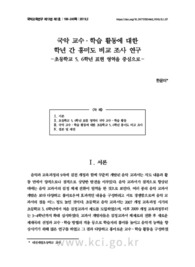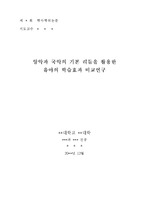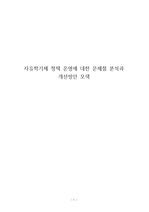

PARTNER
검증된 파트너 제휴사 자료
국악 교수·학습 활동에 대한 학년 간 흥미도 비교 조사 연구 (A Comparative Study on the Fifth and Sixth Grade Students’ Interest Level in Teaching and Learning Activities for Korean Music)
42 페이지
최초등록일 2025.03.11
최종저작일
2019.02

-
미리보기
서지정보
· 발행기관 : 한국국악교육연구학회
· 수록지 정보 : 국악교육연구 / 13권 / 1호 / 199 ~ 240페이지
· 저자명 : 한윤이
초록
본 연구는 음악 교과서의 국악 교수․학습 활동에 대한 초등학교 5학년과 6학년 학생들의 흥미도를 비교 분석하여 학교 현장에 적합한 학년별 국악 교수․학습 활동을 제안하는 데 목적이 있다. 이를 위하여 먼저 2009와 2015 개정 초등학교 5~6학년 음악 교과서의 국악 교수․학습 활동을 고찰하여 공통적이고 비중이 높은 활동을 분석하였다. 이렇게 분석한 내용과 흥미도 검사 도구 개발 선행연구를 참고하여 6개의 설문 문항을 제작하고 2년 동안 수업과 설문을 실행하여 동일 학년도의 서로 다른 집단인 5학년과 6학년, 다른 학년도의 같은 집단인 5학년과 6학년의 흥미도를 조사하였다. 그리고 두 집단 간에 통계적으로 유의미한 응답의 차이가 있는지 검증하기 위해 유의 수준 =.01에서 카이자승(χ²)검증을 실시하였다.
설문 조사를 비교 분석한 결과 첫째, ‘시김새 살려 민요 부르기’와 ‘민요에 맞추어 신체 표현하기’ 활동에 대한 초등학교 5학년과 6학년의 흥미도는 유의미한 차이가 나타났으며, 초등학교 5학년이 6학년보다 높은 흥미도를 보였다. 둘째, ‘메기고 받으며 민요 부르기’와 ‘장구 연주하기’ 활동에 대한 초등학교 5학년과 6학년의 흥미도는 통계학적으로 유의미한 차이가 나타나지 않았다. 이 활동에 대한 초등학교 5학년과 6학년의 흥미도는 통계학적으로 차이가 없지만 빈도 분석 결과 두 학년에서 모두 흥미도가 높게 나타났다. 셋째, ‘민요 가사 바꾸어 부르기’와 ‘단소 연주하기’ 활동은 동일 학년도의 다른 집단인 5학년과 6학년에서는 유의미한 차이가 없었으나 다른 학년도의 동일한 집단인 5학년과 6학년에서는 유의미한 차이가 있었다. 이는 두 활동에 대한 흥미도가 5학년과 6학년 간에 뚜렷하게 차이가 있다고 확신할 수 없음을 시사한다.
이와 같은 결과를 통해 초등학교 6학년은 교과서의 국악 교수․학습 활동에 있어서 5학년과 다르게 구성해야할 필요가 있음을 알게 되었다. 초등학교 6학년은 단순하게 민요를 듣고 따라 부르거나 신체로 표현하는 활동에 대한 흥미도가 낮기 때문에 이러한 활동을 지양하거나 흥미를 높일 수 있는 교수․학습 방법의 개발이 필요함을 제의하였다. 또한 다양한 방법으로 함께 노래 부르기거나 장구와 같은 악기 연주에는 흥미도가 높으므로 이러한 활동을 중심으로 수업에 적극적으로 참여할 수 있도록 국악 교수․학습 활동을 구성할 것을 제안하였다.영어초록
This study aimed to propose practical and effective Korean music teaching and learning activities by grade level through comparing and analyzing 5th and 6th-grade students’ interest level in Korean music activities included in music textbooks. To do so, it analyzed the Korean music teaching and learning activities commonly presented in the 2009 and 2015 revised elementary music textbooks for 5th and 6th grade. Based on the analysis and previous studies, a questionnaire of six items was designed, and the survey and classes were conducted for two years targeting fifth and sixth graders in the same school year and the same group of fifth and sixth graders respectively in different school years. To determine whether there is a statistically significant difference between the two groups, a chi-squared test was conducted at the significance level α = .01.
The findings of the survey are as follows. Firstly, for the activities of ‘singing folk songs with an expression of sigimsae’ and ‘physically expressing themselves to folk songs,’ there was a significant difference in the interest level of the 5th and the 6th-grade students, with the 5th grade displaying a higher level of interest than the 6th grade. Secondly, for the activities of ‘singing folk songs in the form of call and response’ and ‘playing rhythmic patterns on the jangu,’ there was no statistically significant difference in the interest level of the 5th and the 6th grade. Although there was no statistically significant difference between the two grades for the aforementioned activities, the result of frequency analysis displayed that both grades were all highly interested. Thirdly, for the activities of ‘changing lyrics of folk songs’ and ‘playing the danso,’ there was no significant difference between the 5th and the 6th grade, as a different group of the same school year, but there was a significant difference between the 5th and the 6th grade, as the same group of different school years. This showed that it was uncertain that there was a significant difference in the interest level of the 5th and the 6th grade for these two activities.
The results of the study indicate that instructional components of music textbooks for 6th graders should differ from those for 5th graders. For 6th graders in elementary schools typically have a low level of interest in merely singing folk songs and expressing themselves through their body, it is proposed to discourage such activities and instead to construct Korean music teaching and learning activities that can promote their interest level and active participation such as singing together or playing musical instruments in various ways.참고자료
· 없음태그
-
자주묻는질문의 답변을 확인해 주세요

꼭 알아주세요
-
자료의 정보 및 내용의 진실성에 대하여 해피캠퍼스는 보증하지 않으며, 해당 정보 및 게시물 저작권과 기타 법적 책임은 자료 등록자에게 있습니다.
자료 및 게시물 내용의 불법적 이용, 무단 전재∙배포는 금지되어 있습니다.
저작권침해, 명예훼손 등 분쟁 요소 발견 시 고객센터의 저작권침해 신고센터를 이용해 주시기 바랍니다. -
해피캠퍼스는 구매자와 판매자 모두가 만족하는 서비스가 되도록 노력하고 있으며, 아래의 4가지 자료환불 조건을 꼭 확인해주시기 바랍니다.
파일오류 중복자료 저작권 없음 설명과 실제 내용 불일치 파일의 다운로드가 제대로 되지 않거나 파일형식에 맞는 프로그램으로 정상 작동하지 않는 경우 다른 자료와 70% 이상 내용이 일치하는 경우 (중복임을 확인할 수 있는 근거 필요함) 인터넷의 다른 사이트, 연구기관, 학교, 서적 등의 자료를 도용한 경우 자료의 설명과 실제 자료의 내용이 일치하지 않는 경우
“국악교육연구”의 다른 논문도 확인해 보세요!
-
국악치료교육이 정서지능과 사회성 증진에 미치는 영향 44 페이지
본 연구는 집단 국악치료 수업이 병행 가능 할 수 있도록 교수․학습 과정안을 다양하게 재구성하여 국악치료교육이라는 새로운 장르의 수업모델을 제시하려는 목적으로 이루어졌다. 2015개정 음악과 교육과정 5~6학년군 생활화 영역 내용요소에 ‘음악과 건강’이 처음으로 도입되어 2019년부터 적용됨을 파악하고, 국악 요소를 활용한 국악치료교육 교수․학습 과정안을 .. -
강태홍(姜太弘)의 일화(逸話)를 활용한 가야금 산조 지도 방안 22 페이지
음악은 외형적인 구조와 내면적인 이야기가 조화를 이루어 완성된 것이며 이에 대한 이해가 뒷받침 될 때 균형 잡힌 음악 교육이 이루어질 수 있다. 본 연구는 이러한 점에 착안하여 가야금 실기 지도를 위해 악곡에 담긴 일화를 활용한 연주의 질 향상과 연주자의 올바른 태도 형성에 목적을 두고 연구되었다. 이를 위해 강태홍류 가야금 산조 일화를 활용하였으며 그 안..
찾으시던 자료가 아닌가요?
지금 보는 자료와 연관되어 있어요!
문서 초안을 생성해주는 EasyAI



